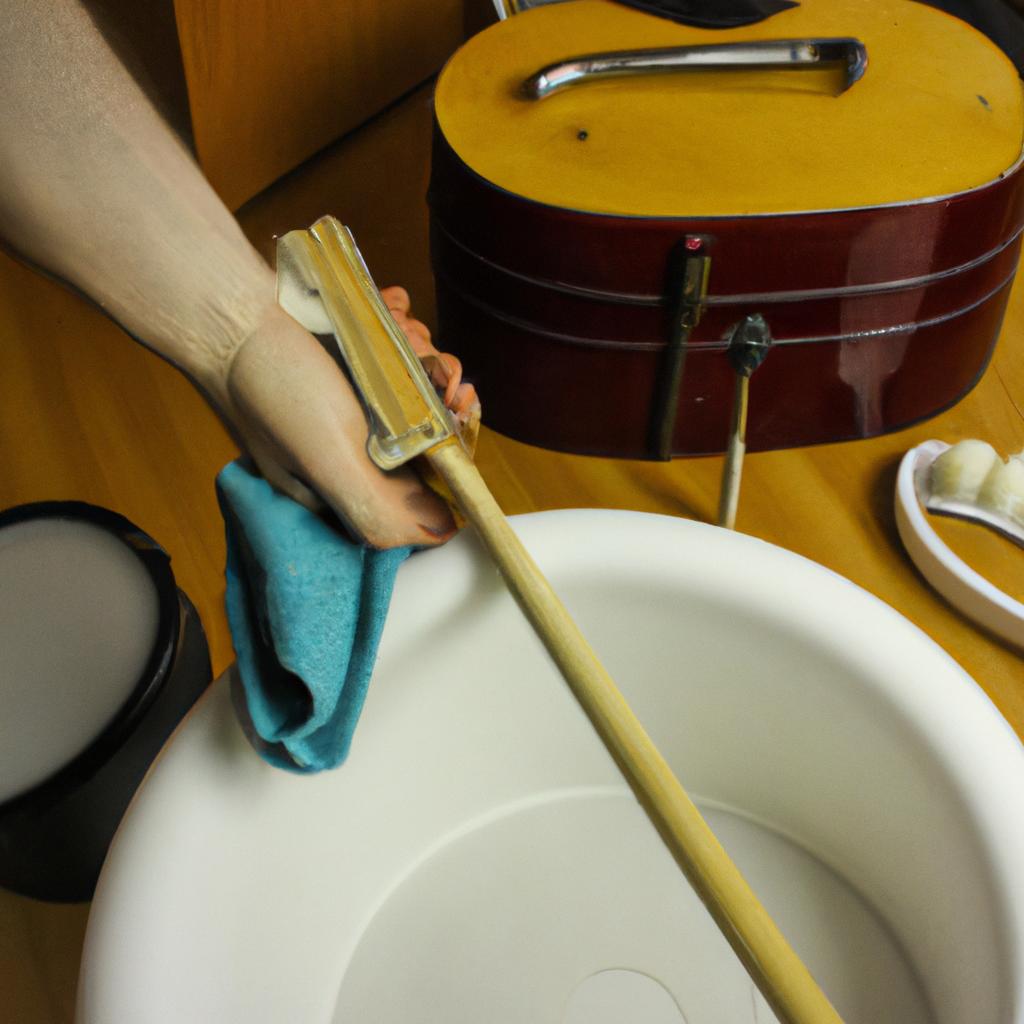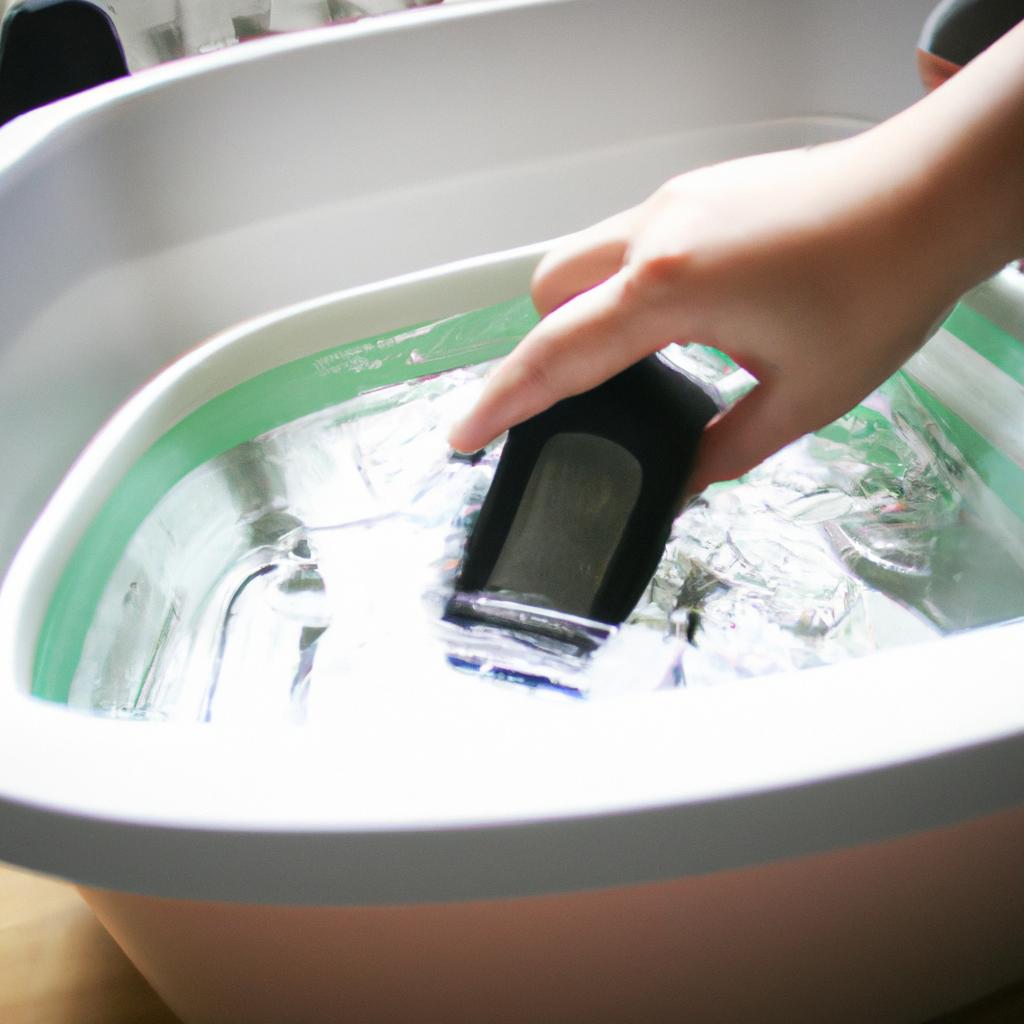Cleaning brushes are an essential part of maintaining the longevity and functionality of various instruments and supplies. Without proper maintenance, these tools can quickly accumulate dirt, grime, and other contaminants that hinder their effectiveness. For instance, consider a scenario where a painter neglects to clean their paintbrushes after each use. Over time, dried paint residue builds up on the bristles, resulting in stiffened brush hairs that do not distribute paint evenly or smoothly. This example highlights the importance of regular cleaning for brushes used in creative endeavors.
In addition to preserving optimal performance, keeping brushes clean also promotes hygiene and prevents cross-contamination between different substances or colors. Laboratory equipment such as test tubes and beakers must undergo thorough cleaning to remove any residual chemicals before they can be safely reused for another experiment. Similarly, makeup artists need to ensure that their cosmetic brushes are meticulously cleaned to prevent bacteria buildup and potential skin infections among clients. Therefore, understanding effective cleaning techniques is crucial for anyone who relies on brushes as necessary tools in their respective fields.
Types of Brushes
Imagine a scenario where you are an artist preparing to paint a masterpiece. You reach for your trusty brush, only to find it covered in dried paint and clumped bristles. Frustrated, you realize the importance of proper maintenance for cleaning brushes. Understanding the different types of brushes available can help ensure that you choose the right approach to care for them.
There are various types of brushes used for different purposes, including painting, makeup application, and even industrial cleaning. Each type has unique characteristics that require specific care and attention. Let’s explore three main categories: natural hair brushes, synthetic brushes, and specialty brushes.
1. Natural Hair Brushes
- Made from animal hairs such as squirrel, sable, or hog.
- Known for their ability to hold more paint due to their porous nature.
- Require gentle cleaning techniques with mild soap and lukewarm water.
- Should be stored upright or suspended to prevent damage to the bristles.
2. Synthetic Brushes
- Constructed using nylon or polyester fibers.
- Ideal for acrylic or water-based paints as they provide a smoother finish.
- Generally easier to clean compared to natural hair brushes.
- Can withstand harsher cleaning methods like soaking in soapy water.
3. Specialty Brushes
- Designed for specific tasks such as varnishing, stenciling, or lettering.
- Often have unique shapes or sizes tailored to their intended use.
- Cleaning requirements may vary depending on the purpose of the brush.
To further emphasize the significance of caring for your brushes properly, consider these points:
- Proper maintenance enhances longevity: By following appropriate cleaning techniques based on brush type, you can extend their lifespan significantly.
- Consistent care ensures optimal performance: Regularly cleaned and well-maintained brushes will perform better during use than neglected ones affected by residue buildup or damaged bristles.
- Hygiene matters across industries: Whether you are an artist, makeup enthusiast, or industrial worker, clean brushes contribute to better hygiene and more precise results.
- Neglected care leads to costly replacements: Failing to maintain brushes can result in irreparable damage or the need for frequent replacements. Proper cleaning practices will save you money in the long run.
By understanding which substances are suitable for different types of brushes, you can further enhance their longevity and performance without compromising their quality.
Next Section Transition: “Now that we have explored the various types of brushes available, let’s move on to discussing how to choose the appropriate cleaning agents.”
Choosing the Right Cleaning Agents
After understanding the different types of brushes, it is crucial to learn how to properly maintain these instruments and supplies. By following a few maintenance tips, you can ensure that your brushes remain in optimal condition for extended use. Let’s explore some essential techniques and recommendations for maintaining cleaning brushes effectively.
Example:
Imagine a scenario where an artist uses their paintbrushes regularly but fails to clean them thoroughly after each use. Over time, dried paint accumulates on the bristles, making them stiff and less effective at applying paint smoothly. This neglect not only hampers the brush’s performance but also shortens its lifespan. To avoid such issues, proper maintenance practices are necessary.
Maintenance Tips for Cleaning Brushes:
-
Regular Cleaning Routine:
- Establish a regular cleaning routine by incorporating it into your workflow.
- Clean your brushes immediately after using them to prevent any residue from drying up and causing damage.
- Use lukewarm water and mild soap or specialized brush cleaners when washing your brushes.
- Gently swirl the brush heads in soapy water while being careful not to bend or damage the bristles.
-
Proper Drying Techniques:
- After rinsing off all residues, gently squeeze excess water out of the bristles with your fingers or a soft cloth.
- Reshape the bristles back into their original form before setting them aside to dry naturally.
- Avoid using excessive heat sources such as hairdryers or heaters as they can cause bristle damage.
-
Storage Considerations:
- Store cleaned and dried brushes upright or horizontally in a designated holder or case.
- Ensure that there is enough space between each brush head to prevent deformation or transfer of pigments.
- Keep brushes away from direct sunlight, extreme temperatures, and humidity levels to maintain their integrity.
- Taking proper care of your brushes ensures longevity and optimal performance.
- Neglecting maintenance can lead to bristle damage, decreased effectiveness, and increased replacement costs.
- Regular cleaning helps maintain the quality and integrity of your brushes over time.
- Proper storage prevents contamination, deformation, or loss of valuable brush hairs.
Emotional Table:
| Maintenance Tips | Benefits |
|---|---|
| Regular cleaning routine | Ensures longevity |
| Proper drying techniques | Maintains brush quality |
| Storage considerations | Prevents damage and contamination |
In summary, maintaining cleaning brushes is crucial for their longevity and optimal performance. Establishing a regular cleaning routine, using proper drying techniques, and considering appropriate storage conditions are all key factors in ensuring that your brushes remain in excellent condition. By following these maintenance tips diligently, you can extend the lifespan of your brushes and avoid unnecessary expenses associated with frequent replacements.
Now that we have explored essential maintenance tips, let’s delve into the specifics of proper brush cleaning technique to ensure thorough removal of debris and residues.
Proper Brush Cleaning Technique
Cleaning Brushes: Maintenance Tips for Instruments and Supplies
Choosing the Right Cleaning Agents (Continued)
Now that we have discussed the importance of selecting the appropriate cleaning agents, let us delve deeper into some key factors to consider. To illustrate this further, let’s take the case of a professional artist who uses various brushes in their practice. The artist has invested in high-quality brushes made from different materials such as synthetic fibers, natural hair, and bristles. Understanding how to properly maintain these brushes is crucial to ensure longevity and optimal performance.
When it comes to maintaining your cleaning brushes, here are some essential tips:
-
Regular Inspection: Before each use or storage, carefully examine your brush for any signs of damage or wear. Look out for loose bristles, bent ferrules, or frayed hairs. Addressing these issues promptly will prevent further damage and guarantee effective cleaning.
-
Gentle Cleansing Techniques: Avoid harsh scrubbing or excessive force when cleaning your brushes, as this may cause them to lose shape or shed bristles. Instead, gently massage the brush with mild soap or specialized brush cleaner using circular motions until all residue is removed.
-
Proper Storage: After cleaning your brushes thoroughly, allow them to air dry completely before storing them upright with the bristle side facing up. This prevents water accumulation at the base of the bristles and maintains their original shape.
-
Replacement Schedule: Despite diligent maintenance efforts, it is important to recognize when a brush has reached its lifespan limit. Keep track of usage frequency and evaluate whether a particular brush no longer performs optimally even after thorough cleaning.
| Brush Type | Neglected Cleaning | Regular Cleaning | Diligent Cleaning |
|---|---|---|---|
| Synthetic | Loss of shape | Moderate performance | Prolonged lifespan |
| Natural Hair | Frayed bristles | Average performance | Enhanced longevity |
| Bristles | Bent ferrules | Subpar results | Extended usability |
With these maintenance tips in mind, you can ensure that your cleaning brushes remain in optimal condition for an extended period. In the subsequent section on “Drying and Storage,” we will discuss additional techniques to further preserve the quality of your instruments and supplies.
Drying and Storage
Having discussed the proper technique for cleaning brushes in the previous section, it is now important to understand how to effectively dry and store them. By following these guidelines, you can ensure that your instruments and supplies remain in optimal condition for extended periods of use.
Drying Brushes:
To avoid damage or deformation, it is crucial to allow brushes to dry thoroughly after cleaning. Here’s an example that illustrates the importance of this step: imagine a painter who fails to properly dry their paintbrushes before storing them. The residual moisture could lead to mold growth on the bristles, rendering the brush unusable and necessitating its replacement.
To facilitate efficient drying, consider implementing the following strategies:
- Lay brushes flat or hang them upside down: This allows excess water to drain away from the ferrule (the metal part that connects the bristles with the handle), preventing water accumulation that may cause rust or loosen adhesive.
- Utilize air circulation: Place brushes near a fan or in a well-ventilated area to expedite drying time.
- Avoid direct heat sources: While it may be tempting to speed up drying by placing brushes near heaters or using hairdryers, excessive heat can damage delicate bristles and handles.
- Patience is key: Allow ample time for brushes to air-dry naturally, ensuring they are completely moisture-free before proceeding with storage.
Storage Options:
After drying your brushes thoroughly, appropriate storage becomes essential for maintaining their longevity. Consider utilizing one of the following methods:
| Method | Description | Advantages |
|---|---|---|
| Brush roll/case | A fabric roll or case with individual compartments designed specifically for holding multiple brushes | Offers protection against dust and accidental damage |
| Drawer dividers/organizers | Small trays or containers placed within drawers that help keep brushes separated and organized | Maximizes space efficiency while keeping brushes easily accessible |
| Wall-mounted brush holders | Racks or hooks mounted on walls that allow brushes to hang freely, keeping them visible and easily accessible | Provides a decorative display while ensuring quick access to brushes |
These storage options not only protect your brushes from damage but also contribute to a neat and organized workspace. By following these practices, you can prolong the lifespan of your brushes, saving both time and money.
Understanding how to properly dry and store your cleaning brushes is vital in maintaining their quality over time. However, it is equally important to establish an appropriate frequency for cleaning. The subsequent section will delve into this aspect further, shedding light on the optimal intervals for different types of instruments and supplies.
[Proceeding Section H2]
Frequency of Cleaning
After thoroughly cleaning your brushes, the next important step is to ensure proper drying and storage. Let’s consider an example scenario: imagine you have just finished cleaning a set of paintbrushes that were used for oil painting. It is crucial to dry these brushes properly in order to maintain their quality and prevent damage.
To begin with, one effective technique for drying brushes is to gently squeeze out any excess water or cleaning solution from the bristles using a clean cloth or paper towel. Avoid twisting or pulling on the bristles too forcefully, as this can cause them to become misshapen or even break off. Once most of the moisture has been removed, reshape the brush tips by gently shaping them back into their original form.
Next, it is essential to allow the brushes to air-dry completely before storing them away. Lay them flat on a clean surface or hang them upside down using clips attached to a line. This will enable any remaining moisture to evaporate naturally without causing damage to the handles or ferrules. Additionally, make sure not to store damp brushes in closed containers or cases, as this can create a breeding ground for mold and mildew.
Properly dried and reshaped brushes should then be stored in appropriate containers or holders specifically designed for brush storage. Here are some key points regarding suitable storage options:
- Use separate compartments or slots within the container/holder for each brush.
- Ensure that there is enough space between each brush to avoid crushing or deforming the bristles.
- Consider investing in specialized brush rolls/cases made from breathable materials like canvas or nylon.
- If possible, store brushes with their bristle ends facing upward to prevent flattening.
By following these guidelines for drying and storage, you can prolong the lifespan of your instruments and supplies while also maintaining their optimal performance.
Common Mistakes to Avoid
Transitioning smoothly from the previous section on the frequency of cleaning, it is essential to understand some common mistakes that individuals often make when maintaining their cleaning brushes. By avoiding these errors, you can ensure the longevity and effectiveness of your instruments and supplies.
Let us consider a hypothetical scenario where a musician frequently uses a saxophone brush but neglects to clean it properly after each use. Over time, this neglect leads to the accumulation of dirt, debris, and moisture residue in the bristles. As a result, not only does the brush lose its efficiency in removing particles from the instrument’s surface, but it also becomes a breeding ground for bacteria and fungi. This case study highlights how improper maintenance practices can have detrimental consequences.
To help you avoid such pitfalls, here are several common mistakes people make when caring for their cleaning brushes:
- Neglecting regular cleaning: Failing to clean brushes regularly allows buildup of contaminants that compromise their performance.
- Using harsh or incorrect cleaning solutions: Certain solvents or cleaners may damage brush bristles or corrode metallic parts if used improperly.
- Improper storage: Storing brushes in damp environments or without proper airflow can lead to mold growth or deformation of bristles.
- Not replacing worn-out brushes: Brushes with frayed bristles become less effective at removing debris and risk scratching delicate surfaces.
Consider the following table as a visual aid displaying potential consequences resulting from these mistakes:
| Common Mistake | Consequence |
|---|---|
| Neglecting regular cleaning | Reduced efficacy in removing particles; increased risk of microbial contamination |
| Using harsh or incorrect cleaning solutions | Damage to brush bristles or corrosion of metallic parts |
| Improper storage | Mold growth; deformation of bristles |
| Not replacing worn-out brushes | Reduced effectiveness; potential for surface scratches |
By being aware of these common missteps and following best practices outlined earlier in this guide, you can maintain your cleaning brushes effectively, ensuring they perform optimally and prolonging their lifespan.
In summary, it is crucial to avoid common mistakes when caring for cleaning brushes. Neglecting regular cleaning, using harsh or incorrect solutions, improper storage, and not replacing worn-out brushes can all lead to various consequences detrimental to the instruments’ maintenance. By following proper procedures and avoiding these errors, you can ensure your cleaning brushes remain efficient and effective in maintaining the cleanliness of your instruments and supplies.




